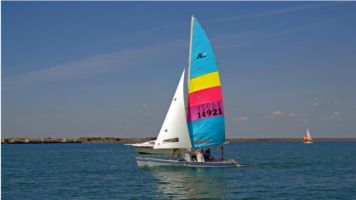SabresfortheCup wrote:
Tom, while I know that a symmetric spinnaker at ~130+ degrees TWA acts only as a kite to create drag (relative to the wind, but driving force for the boat), my understanding of an asymmetrical spinnaker at ~135 degrees TWA (~90 AWA) is that they're used much like any other sail on the boat, to primarily generate lift, and therefore still acts as a foil, unless the apparent wind shifts further aft to somewhere around 110-120 degrees AWA?
For conventional/monohull & symmetrical spinnakers, they are treated as essentially parachutes with a coefficient of drag of between 1.3 and 1.5. I may have to dust off Principles of Yacht Design (excellent book for the technically inclined, btw) when I get home for a bit more information, but as I recall the formula stays the same, you're just working exclusively with drag rather than a combination of lift and drag.
That was my point. If you sail into a deep enough window downwind, you can actually pull the boards up and you'll go even faster as underwater drag is reduced and the sail is just pulling the boat along. There is no "lift" to counteract. On the other hand, head up far enough to the wind and those boards will have to be kept down to prevent excessive leeway and heel. The deeper the cut on that sail, the narrower that window is going to be. The flatter the cut, the closer to the wind you can use it and the more it's going to perform like a larger version of your present sails. More like a gennaker for instance.






